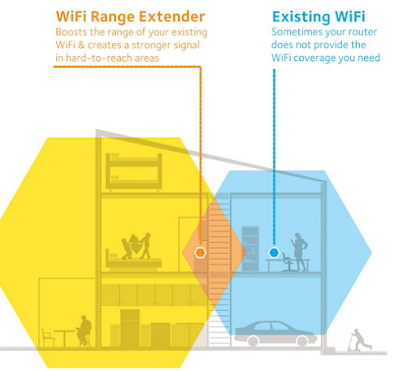Boost the WiFi Signal at home with Wifi Extenders

WiFi Extenders, also called WiFi Boosters, are a simple and economical way
to end the mystery and bring dead zones to life.
The dead zone – that spot in your house where WiFi inexplicably seems to
disappear. With all the devices, metal appliances, and architectural
interference in the average home, even the fastest, most powerful WiFi router
can miss a few spots.
Wireless Repeaters
Wireless repeaters are first generation WiFi signal extenders. As the name
implies, wireless repeaters re-broadcast the WiFi signal received to a finite
localized area. The quality of WiFi signal strength received by the wireless
repeater will be the same WiFi signal strength distributed. Latency, or WiFi
network response time, is typically increased. If you need a short hop, have
less than 5 wireless devices and are not going to stream anything, a repeater
might work – but I doubt it.
Wireless Range Extenders
Wireless range extenders are stand-alone equipment which sit between your
wireless router and the location where you want better wireless coverage. Similar
to a wireless repeater, a wireless range extender grabs existing WiFi
signal from your wireless router and re-broadcasts it. Range extenders
rebroadcast on a different wireless channel from the one used by your wireless
router. The challenge with range-extenders is location.
Incorrect placement means a range extender may not obtain sufficient WiFi
signal from your router to simultaneously rebroadcast, stream and engage in
online gaming or watching a video.

WiFi Network Extenders
WiFi Network Extenders are the best WiFi boosters for consistent, reliable
high speed WiFi to every floor and corner of your home. Unlike repeaters or
range extenders that rebroadcast existing WiFi signals, Network
Extenders communicate directly with your gateway or WiFi router using a
wire.
Just like cellular towers, WiFi Network Extenders use a wire or cable
as the means of communicating back to the router or source. Actiontec’s WiFi
Network Extenders then use that “huge pipe” to create a second or third WiFi
boosted network.
Simple Setup
Not very long ago, setting up a range extender required a bit of technical
expertise and a good deal of patience to find the best location (ideally
halfway between the router and the dead zone). But most of today’s routers and
range extenders support WPS (Wi-Fi Protected Setup), which makes pairing the
two as simple as pressing a couple of buttons, naming your new extended
network, and creating a network password.
Moreover, nearly all manufacturers offer web-based setup wizards and
illustrated instructions that will help you configure basic wireless settings.
Some (but not all) extenders are equipped with LED status indicators that tell
you if the extender is too far from the router.
Extenders can also offer advanced router-like features such as guest
networking, access scheduling, and media server capabilities.
Wall-plug or Desktop Design?
WiFi extenders come in two types of form factors, ones that are meant for
desktop placement and ones that plug directly in the wall, sometimes referred
as wall-plugged.
If you want a less obtrusive, wire-free design that blends in nicely within
your home environment a wall-plug extender is your best option.
A desktop extender is a great choice if you want up to five Ethernet ports
to connect more network-ready wired devices and USB storage options

Comments
Post a Comment